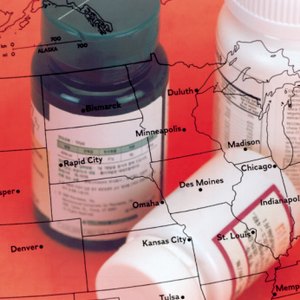
The so called "donut hole" in Social Security refers to a prescription drug coverage gap found in Medicare Part D prescription drug plans. The insurance carrier pays its portion of prescription drug costs, up to a certain amount. Past that point, the subscriber is responsible for all drug costs up to a catastrophic maximum, after which insurance drug payments resume.
Big Gap
Under Medicare Part D prescription plans, beneficiaries pay a $310 annual deductible out of pocket. After that, beneficiaries pay 25 percent of drug costs, with the insurance carrier paying the other 75 percent. But when the beneficiary runs up $2,530 in covered drug costs in the same year, he enters the donut hole and is responsible for paying the next $3,607 from his own pocket. Once he has spent that amount, insurance coverage resumes for 95 percent of prescription costs for the rest of the year.
Congress Acts
Medicare beneficiaries have complained about the donut hole ever since Medicare Part D began in 2006. Congress in 2010 passed the Affordable Care Act to reform health care. Among other things, this act will make prescription drugs more affordable for seniors by phasing out the Medicare Part D donut hole in stages until 2020, when it disappears completely. Part D beneficiaries who fell into the donut hole in 2010 received a $250 refund check.
Donut Hole Relief
Part D beneficiaries who fall into the donut hole in 2011 will receive a 50 percent discount on brand-name prescription medications, provided by the drug manufacturer, until they leave the donut hole. In addition, they will receive a 7 percent discount on the cost of generic drugs. The discounts will apply regardless of whether you fill your prescriptions at your local pharmacy or by mail order. You shouldn’t have to do anything to get these discounts.
Phaseout Schedule
In 2013 and 2014, Part D beneficiaries will get a 2.5 percent brand-name discount, in addition to the 50 percent discount. That brand discount rises to 5 percent in 2015 and 2016, then rises by 5 percent annually until it hits 25 percent for 2020 and beyond. Combined with the 50 percent manufacturers’ discount, that will mean beneficiaries will be paying only 25 percent of their drug costs, and the donut hole will be gone. The discount on generic drugs will rise to 14 percent in 2012, to 21 percent in 2013, and then increase by 7 percent each year until 2020 when it will be 75 percent, leaving beneficiaries to pay only 25 percent out of pocket.
References
Writer Bio
Herb Kirchhoff has more than three decades of hands-on experience as an avid garden hobbyist and home handyman. Since retiring from the news business in 2008, Kirchhoff takes care of a 12-acre rural Michigan lakefront property and applies his experience to his vegetable and flower gardens and home repair and renovation projects.

